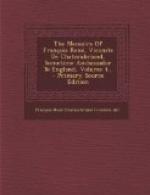|
This section contains 6,203 words (approx. 21 pages at 300 words per page) |

|
SOURCE: Hamilton, James F. “The Gendering of Space in Chateaubriand's Combourg: Archetypal Architecture and the Patriarchal Object.” Symposium: A Quarterly Journal in Modern Literatures 50, no. 2 (summer 1996): 101-13.
In the following essay, Hamilton analyzes the use of spatial arrangements in Memoirs. In depicting Combourg, his childhood home, Chateaubriand offered an archetypal architecture which psychologically represented his hierarchical family structure and the dominance of his father.
Cet étroit espace me parut propre à renfermer mes longues espérances; spatio brevi spem longam reseces.
—(Horace, Odes)1
Time seems to have precedence over space in our understanding of French Romanticism. Time distinguishes human nature in its awareness of freedom and mortality, which engenders the feelings of melancholy and anguish so dramatically brought into modern consciousness by Rousseau and the Romantics. This ontological truth, popularized by Rollo May's tribute to the nineteenth-century origins of existentialism, also prevails in critical studies on Chateaubriand's Mémoires...
|
This section contains 6,203 words (approx. 21 pages at 300 words per page) |

|


